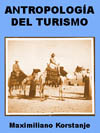Maximiliano Korstanje
Esta página muestra parte del texto pero sin formato.
Puede bajarse el libro completo en PDF comprimido ZIP
(70 páginas, 244 kb) pulsando aquí
REFERENCIA BIBLIOGRAFICA.
• Ainsworth M. D
1974. “The Development Of Infant-Mother Attachment”. Review of Child Development. University of Chicago: Chicago Press
• Anderson J.W
1972. “Attachment Behaviour out of Doors”. Cambridge: Cambridge University Press.
• Baker P. J
2002. “An Evaluation of Relational contextual variables that may influence stability across rating and attachment styles”. Dissertation Abstract International, Section B63, 1-B.
• Belsky J y Rovine M.
1987. “Temperament and Attachment: security in the Strange situation. An empirical reaprochment. Child Development, 58;787-792.
• Bowlby J.
a) 1989. Una Base Segura: aplicaciones clínicas de la teoría del apego. Buenos Aires: Paidos
b) 1986. Vínculos Afectivos: formación, desarrollo y pérdida. Madrid: Editorial Morata.
• Bretherton I.
1985. “Atthachment Theory: retrospect and prospect. Child Development, 50:1-22.
• Casullo A. M.
2004. “Vínculo de Apego Romántico en Adultos: escala de auto evaluación”. Revista Psicodiagnosticar. (Publicación en curso)
• Cater J. I y Easton P. M
1980. “Separation and Other Stress in Child Abuse”. Lancet 1:972
• Darwin C.
1959. The Origin of Species by Means of Natural Selection. Londres: Editorial Murray.
• Delgado Oliva A.
2004. “Estado Actual de La Teoría del Apego”. Revista de Psiquiatría y Psicología del Niño y del Adolescente, 4:55-69.
• Fairbairn W.R.D.
1962. Estudio Psicoanalítico de la Personalidad. Buenos Aires: Editorial Hormé.
• Feeney B.C y Cassidy R.
2003. “Reconstructive Memory related to adolescent-parent conflict interaction: the influence of attachment related representations of immediate perceptions and changes in perception over time. Journal of Personality and Social Psycology, 85: 945-950.
• Fonagy P.
2004. Teoría del Apego y Psicoanálisis. Barcelona: Editorial Spaxs.
• Frommer, E y O Shea, G.
1973. “Antenatal identification of women liable to have problems in managing their infants. British Journal of Psychiatry, 123: 149-156.
• Hazan C. y Shaver P.
1990. “Love and Work: an attachment theoritical perspectiva”. Journal of Personality and Social Phsycology, 59:270-275.
• Heinicke C.
1956. “Some Effects of Separating Two-years Old Children from their Parents: a comparative study.” Revista Human Relations, 9:105-176.
• Isabella R.A.
1993. “Origins of Atthachment: Maternal interactive Behavior across the first year. Child Development, 64:605-621.
• Jones E.
1996. “Introduction to the Special section on Attachment and Psychopatology: part 1.” Journal of Consulting and Clinical Psychology. Vol 64 (1):5-8.
• Klaus M. H y Kennell J. H
1975. Maternal Infant Bonding. Saint Louis: Editorial Mosby.
• Kohut H.
1971. The Analisys of the Self. International University Press, New York.
• Main M.
2001. “Las Categorías Organizadas del Apego en el infante, en el niño y en el adulto: atención flexible versus inflexible bajo estrés relacionado con el apego”. Revista de Psicoanálisis, Apertura Psicoanalítica. Número 8.
• Mead M.
1994. Sexo y Temperamento. Barcelona: Editorial Altaya.
• Lynch M.
1975. “Ill-health and Child Abuse”, The Lancet.
• Lyons-Ruth K.
1996. “Attachment Relationships among children with agressive behaviour problems: the role of disorganized erly attachment patterns”. Journal of Consulting and clinical Psychology. 64 (1):64-73.
• Schaffer H. R y Crook C. K.
1979. “The Role of the Mother in early Social Development”, en B. McGurk (comp): Issues in childhood social development, 55-78, Londres.
• Schutz A.
1974. El Problema de la Realidad Social. Buenos Aires: Amorrortu Editores.
• Schuster F. (Compilador)
2004. Popper y Las Ciencias Sociales. Buenos Aires: Editores de América Latina.
• Stevenson-Hinde J y Shouldice A.
1995. “Maternal Interactions and self-reports related to attachment classifications at 4.5 years”. Child Development, 65:583-590.
• Tapia Méndez L. y González Bravo L.
2002. “Descripción de Patrones de Apego en Menores Institucionalizados con Problemas Conductuales”. Revista de Psicología. 11 (2):75:92.
• Thompson P.A
1986. “The Effects of Infant day care through the prism of attachment theory: a critical appraisal”. Early Childhood Research Quaterly, 3:273-280.
• Rutter M.
1979. “Maternal Deprivation, 1972-1978: new findings, new concepts, new approaches”. Child Development, 50:283-305.
• Sroufe L.A.
1985. “Attachment clasification from the perspective of infant-caregiver relationships and infant temperament. Child Development, 56:1-14.
• Stern D.
2000. El Mundo Interpersonal del Infante: una perspectiva desde el psicoanálisis y la psicología Evolutiva. Buenos Aires: Editorial Paidos.
• Vaughan B.E y otros.
1985. “The Impact of Day-Care on Child Mother Attachment Quality: another look at some enduring questions. Child Development, 50:209.
• Vemengo P.
2005. “Apego”. Revista Psicoanálisis Hoy, 4:1-4
• Waters E. y Hamilton E.
2000. “The Stability of Atthacment Security from Infancy to Adolescence en Early Adulthood: General Introduction”. Child Development. 71 (3): 678-679
• Winnicott D. W.
a) 1960. “Ego Distortion in Terms of Ture and False Self”. The Maturational Facilitating enviromentm 140-52, International University Press, New York.
b) 1996. Realidad y Juego. Barcelona: Editorial Gedisa.


